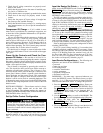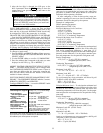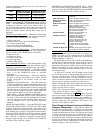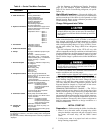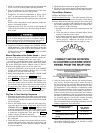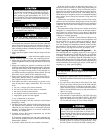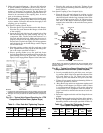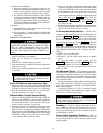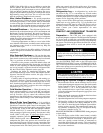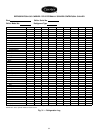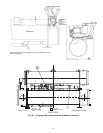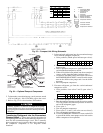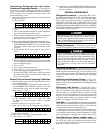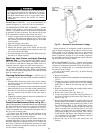
Instruct the Operator — Check to be sure that the op-
erator(s) understands all operating and maintenance proce-
dures. Point out the various chiller parts and explain their
function as part of the complete system.
COOLER-CONDENSER — Relief devices, temperature sen-
sor locations, pressure transducer locations, Schrader fit-
tings, waterboxes and tubes, and vents and drains.
ECONOMIZER/STORAGE VESSEL— Float chambers, re-
lief valves, charging valve.
PUMPOUT SYSTEM — Transfer valves and pumpout sys-
tem, refrigerant charging and pumpdown procedure, lubri-
cation, and relief devices.
COMPRESSORASSEMBLY — Guide vane actuator, trans-
mission, oil cooling system, temperature and pressure sen-
sors, oil sight glasses, integral oil pump, isolatable oil filter,
extra oil and motor temperature sensors, synthetic oil, and
compressor serviceability.
COMPRESSOR LUBRICATION SYSTEM — Oil pump,
cooler filter, oil heater, oil charge and specification, operat-
ing and shutdown oil level, temperature and pressure, oil charg-
ing connections, and seal oil chambers.
EXTERNAL GEAR LUBRICATION SYSTEM — Oil pump,
cooler/filter, oil charge and specification, operating and shut-
down oil level, temperature and pressure, and oil charging
procedures.
CONTROL SYSTEM — CCN and local start, reset, menu,
softkey functions, LID operation, occupancy schedule, set
points, safety controls, and auxiliary and optional controls.
AUXILIARYEQUIPMENT — Starters and disconnects, sepa-
rate electrical sources, pumps, and cooling tower.
CHILLER CYCLES — Refrigerant, motor cooling, lubri-
cation, and oil reclaim cycles.
MAINTENANCE — Scheduled, routine, and extended shut-
downs; importance of a log sheet, water treatment, tube clean-
ing, and maintaining a leak-free chiller.
SAFETY DEVICESAND PROCEDURES — Electrical dis-
connects, relief device inspection, and handling refrigerant.
CHECK OPERATOR KNOWLEDGE — Start, stop, and shut-
down procedures, safety and operating controls, refrigerant
and oil charging, and job safety.
THIS MANUAL — Be sure that the operator is familiar with
the contents of this manual.
OPERATING INSTRUCTIONS
Operator Duties
1. Become familiar with chiller refrigeration and related equip-
ment before operating the chiller.
2. Prepare the system for start-up, start and stop the chiller,
and place the system in a shutdown condition.
3. Maintain a log of operating conditions and document any
abnormal readings.
4. Inspect the equipment, make routine adjustments, and per-
form a controls test. Maintain the proper oil and refrig-
erant levels.
5. Protect the system from damage during shutdown
periods.
6. Maintain the set point, time schedules, and other PIC
functions.
Prepare the Chiller for Start-Up — Follow the steps
described in the Initial Start-Up section, page 57.
Starting the Chiller
1. Start the water pumps if they are not automatic.
2. On the LID default screen, press the LOCAL
or
CCN
softkey to start the system. If the schedule indi-
cates that the current time and date have been established
as a run time and date (a condition referred to as ‘‘oc-
cupied’’) and the 3- and 15-minute start timers have ex-
pired, the start sequence will start. Follow the procedure
described in the Start-Up/Shutdown/Recycle Sequence
section, page 43.
Check the Running System — After the compres-
sor starts, monitor the LID display and observe the param-
eters for normal operating conditions:
1. The oil reservoir temperature should be above 150 F
(66 C) or refrigerant temperature plus 70° F (38° C) dur-
ing shutdown and above 125 F (52 C) during compressor
operation.
2. The bearing oil temperature (BEARING TEMPERA-
TURE on the STATUS01 screen) should be 150 to 200 F
(65 to 93 C). If the bearing oil temperature reads more
than 210 F (99 C) with the oil pump running, stop the
chiller and determine the cause of the high temperature.
Do not restart the chiller until corrected.
3. The oil level should be visible in the lower sight glass
when the compressor is running. At shutdown, oil level
should be halfway in the lower sight glass.
4. The oil pressure should be between 18 and 30 psid (124
to 207 kPad) differential, as seen on the LID default
screen. Typically the reading will be 18 to 25 psid (124
to 172 kPad) at initial start-up.
5. The condenser pressure and temperature vary with the chiller
design conditions. Typically the pressure ranges between
57 and 135 psig (393 and 930 kPa) with a corresponding
temperature range of 60 to 105 F (15 to 41 C) for R-134a.
The condenser entering water temperature should be con-
trolled to remain below the specified design entering wa-
ter temperature to save on compressor kilowatt require-
ments. The leaving condenser water temperature should
be at least 20° F (11° C) above leaving chilled water
temperature.
6. Cooler pressure and temperature also vary with the de-
sign conditions. Typical cooler pressure ranges between
30 and 40 psig (206 and 275 kPa); temperature ranges
between 34 and 45 F (1 and 8 C) for R-134a).
7. The compressor may operate at full capacity for a short
time after the pulldown ramping has ended, even though
the building load is small. The active electrical demand
setting can be overridden to limit the compressor IkW, or
the pulldown rate can be decreased to avoid a high de-
mand charge for the short period of high demand
operation. Pulldown rate can be based on kW rate (LOAD
PULLDOWN %/MIN) or temperature rate (TEMP PULL-
DOWN DEG/MIN) These parameters may be accessed
on the CONFIG screen (see Table 2, Example 6).
8. The oil pump is energized once every 12 hours during
shutdown periods to ensure that the shaft seal is filled
with oil.
Stopping the Chiller
1. The occupancy schedule starts and stops the chiller au-
tomatically once the time schedule is set up.
2. Pressing the Stop button on the control panel for one sec-
ond causes the alarm light to blink once to confirm that
the button has been pressed. Then, the compressor fol-
lows the normal shutdown sequence as described in the
Controls section. The chiller is now in the OFF mode.
The chiller will not restart until the CCN
or
LOCAL
softkey is pressed.
62



